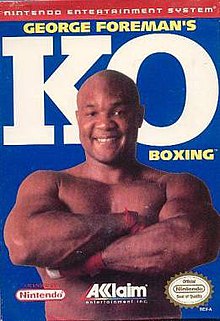George Foreman's KO Boxing
| George Foreman's KO Boxing | |
|---|---|
 | |
| Developer(s) | Beam Software (MD, SNES, NES, GB) SIMS Co., Ltd. (GG, MS) |
| Publisher(s) | Acclaim Entertainment[a] |
| Designer(s) | Graeme Scott[5] |
| Composer(s) | Marshall Parker[5] Andrew Bailey[5] |
| Platform(s) | Super NES, NES, Game Boy, Mega Drive/Genesis, Game Gear, Master System |
| Release | Mega Drive NESGame GearSuper NES |
| Genre(s) | Sports |
| Mode(s) | Single-player, two player[5] |
George Foreman's KO Boxing is a sports video game produced by Acclaim, featuring boxer George Foreman, released in 1992. Three years later, Acclaim released another game with Foreman: Foreman For Real.
Gameplay[edit]
In the 16-bit and Nintendo 8-bit versions, the player assumes the role of George Foreman, who, at 43 years old, is pursuing a quest to become the undisputed heavyweight champion of the world by uniting the title belts of three fictional boxing circuits. Gameplay is almost identical to Beam's previous boxing game, Power Punch II: players are given the option to block the opponent's attempted punches, evade in two different directions, and throwing a wide variety of punches.[6] Victory in a match can be won by knockout, technical knockout or by decision. A knockout requires a boxer to knock his opponent down four times in a three-round match; on the fourth knockdown, the downed boxer will fail to answer the 10-count. A technical knockout is awarded if a boxer is knocked down three times in a single round. If neither of these occur by the end of the third and final round, one boxer is declared the winner by a judge's decision, which is determined by each boxer's punches thrown and landed, knockdowns and total damage done.
In the 16-bit versions, a portrait of each boxer accompanies their energy meters. These portraits become progressively battered and bloody as the fighters take damage.[7] A password system is used in career mode to save progress in the game in lieu of battery backup.[5]
Versions[edit]
The two 16-bit versions of KO Boxing were developed by Beam Software for the Super Nintendo Entertainment System and the Mega Drive, in 1992. Beam Software also developed the Game Boy and the Nintendo Entertainment System versions. The versions for Master System and Game Gear are different, and are based on the Master System version of Heavyweight Champ.[citation needed]
Reception[edit]
| Aggregator | Score |
|---|---|
| GameRankings | 41% (SNES)[10] 39.75% (GB)[11] |
| Publication | Score |
|---|---|
| Total! | 20% (Game Boy)[9] |
| Mega | 35%[8] |
The game was poorly received. Mega said that "the dire gameplay and abysmal graphics make this a game to avoid." Total! reviewer James Beaven went as so far to call it "worse than wrestling games," panning its "jerky" animation and overwhelming difficulty: "the only reason this scored anything was because you can move George a bit."[9] Super Gamer magazine gave the game a review score of 46% stating "George looks the business in the ring restrained beat-'em-up, but not enough moves."[12] Super Play gave an overall score of 18%, they criticized the gameplay saying there is little opportunity to dodge the opponent's punches and the limited movement from the main character, they also gave criticism to the graphics calling it annoying and ropy concluding: "Useless boxing game that’s a strong contender for the worst SNES release of all time."[13] Nintendo Game Zone reviewed the SNES version and gave a score of 60%, they criticized the game's graphics being poor, the inability to move in the ring, lack luster gameplay and the lack of different moves concluding: "Fun, Laughter, and great games play. All these things aren’t to be found in George Foreman's KO Boxing."[14]
Notes[edit]
- ^ Released under the Flying Edge brand on Sega systems
References[edit]
- ^ a b "Release date (Mega Drive/Genesis version)". GameFAQs. Retrieved 2012-04-23.
- ^ a b "Release date (NES version)". GameFAQs. Retrieved 2012-04-23.
- ^ "Press release: 1992-05-19: ACCLAIM BEGINS SHIPMENT OF SEGA SOFTWARE". Sega Retro. 2016-06-10. Retrieved 2023-05-06.
- ^ "Release date (Super NES version)". GameFAQs. Retrieved 2008-07-14.
- ^ a b c d e "Basic game overview". MobyGames. Retrieved 2012-04-23.
- ^ "Differences from Punch-Out!!". Giant Bomb. Retrieved 2012-04-26.
- ^ "Advanced game overview". allgame. Archived from the original on 2014-11-15. Retrieved 2012-04-23.
- ^ Mega review, issue 6, page 45, March 1993
- ^ a b Beaven, James (February 1993). "George Forman K.O. Boxing". Total!. No. 14. p. 69.
- ^ "George Foreman's KO Boxing SNES Review Score". Archived from the original on 2019-05-13.
- ^ "George Foreman's KO Boxing Game Boy Review Score". Archived from the original on 2019-04-04.
- ^ "George Forman's KO Boxing Review". Super Gamer (2). United Kingdom: Paragon Publishing: 122. May 1994. Retrieved March 9, 2021.
- ^ Bielby, Matt (December 1992). "George Foreman's KO Boxing Review". Super Play (2). United Kingdom: Future Publishing: 53. Retrieved March 13, 2021.
- ^ George Foreman's KO Boxing Nintendo Game Zone Review. United Kingdom: Dennis Publishing. April 1993. pp. 62–63. Retrieved August 11, 2021.
- 1992 video games
- Beam Software games
- Black people in art
- Boxing video games
- Cultural depictions of American people
- Cultural depictions of boxers
- Game Boy games
- Game Gear games
- Master System games
- Multiplayer and single-player video games
- Nintendo Entertainment System games
- Sega Genesis games
- Sega video games
- SIMS Co., Ltd. games
- Super Nintendo Entertainment System games
- Video games based on real people
- Video games developed in Australia
- Video games featuring black protagonists
- Video games set in the 1990s
